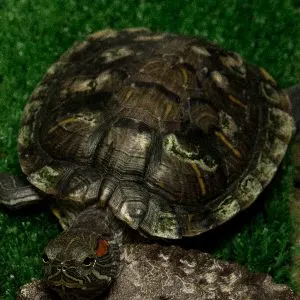
Why does a turtle have white spots on its shell, causes and treatment of white plaque in red-eared and land turtles
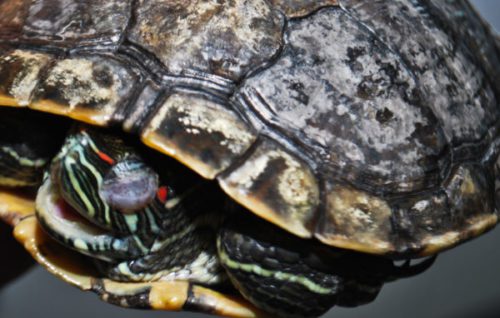
Red-eared turtles are increasingly being adopted as pets, reptiles are absolutely unpretentious, odorless and do not require specific care. Healthy turtles have a strong dark green shell and are distinguished by good activity and excellent appetite. If the shell of the red-eared turtle turns completely white, or light dots or spots appear on it, it is recommended to show the waterfowl to a veterinarian. The ideal option would be an examination by an experienced herpetologist. A white coating on the shell of a red-eared turtle is a kind of indicator indicating a violation of the conditions of detention or serious pathologies.
Contents
Why did the red-eared slider turtle’s shell turn white?
The owners of cute reptiles often do not know what to do if their little pet is covered with strange white spots. The most important thing in such a situation is not to perform independent therapeutic actions: clean off the plaque with sharp objects, smear the pet’s shell with oils or ointments without consulting a specialist, or give antibiotic injections without making a diagnosis. Self-medication is fraught with a deterioration in the state of health or the death of a pet.
White spots on the shell of a red-eared turtle can appear for the following reasons:
- keeping an animal in a pool with a water temperature below 26C;
- long hibernation;
- high water hardness;
- the inability to go to land for drying and heating;
- uncontrolled treatment with antibacterial drugs;
- unbalanced diet;
- hypo- and beriberi;
- lack of trace elements;
- insufficient lighting;
- no ultraviolet lamp for reptiles;
- keeping a turtle in salt water;
- stress;
- shell injury.
Most often, these factors lead to impaired molting or the occurrence of various mycoses – diseases caused by pathogenic fungi. To determine the type of pathogen and the exact cause of the change in the appearance of the reptile, it is necessary to conduct a clinical examination of the turtle using laboratory diagnostic methods.
How can white plaque appear?
Light spots or an unpleasant cotton-like coating on the body of a cute pet most often means that the animal is affected by pathogenic fungi. Self-diagnosis and treatment of a water patient from white spots is highly discouraged.
Even with one pathology, a different manifestation of clinical symptoms is possible:
Any of these symptoms requires immediate contact with a veterinary clinic; if left untreated, foci of necrosis may form in place of white spots, which lead to deformation of the shell and death of the pet. If a turtle with an unusual coating has become lethargic, opens its mouth frequently, squeaks and refuses to eat, the clock may be counting. A similar picture is observed in pneumonia complicated by ringworm.
In what diseases does the shell turn white
Stress factors, violation of feeding and maintenance lead to a whole group of pathologies, manifested by the formation of white spots on the body of the red-eared turtle.
Shedding disorder
Hyperkeratosis, which develops in the presence of systemic pathologies in the animal’s body, circulatory disorders, lack of vitamins and trace elements, keeping the turtle in hard or salty water. In pathology, the shell and skin of an aquatic pet is covered with white skin flaps, which look like a white film. The animal behaves normally, there are no foreign odors or external changes.
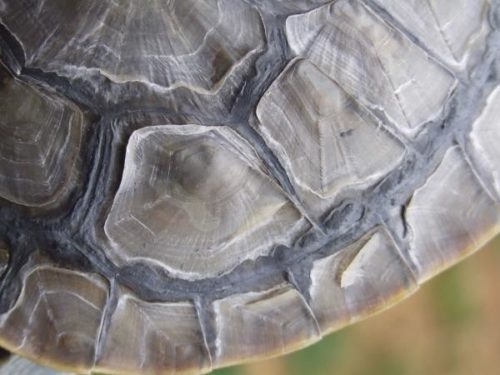
Saprolegniosis
Pathology caused by pathogenic fungi Saprolegnia parpsitica. Under the action of an infectious agent, the formation of a cotton-like light coating resembling a cobweb is observed on the animal’s shell. There is a gray film on the walls of the aquarium, the turtle leaves white marks when moving. Gradually, the shields begin to deform and crumble, white granulomas form on the skin, turning into bleeding ulcers. The turtle becomes lethargic, refuses to feed, in advanced cases paralysis of the limbs and blood poisoning occur.
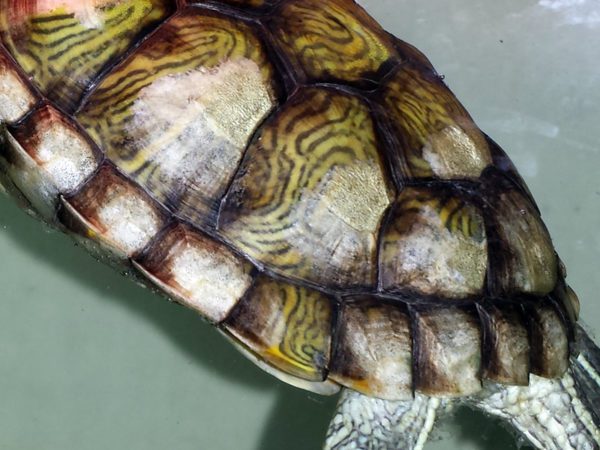
Dermatomycosis
A group of diseases caused by fungi of the genera Candida and Aspergillus. The occurrence of diseases is facilitated by a decrease in immunity in a domestic reptile as a result of long-term antibiotic treatment, with poor-quality feeding and maintenance of the animal. The skin of turtles turns red, light spots form on the back, with the development of the inflammatory process, the shell is deformed, numerous ulcers form on the skin, there is a decrease in activity, limb failure and blood poisoning. If left untreated, the animal may die.
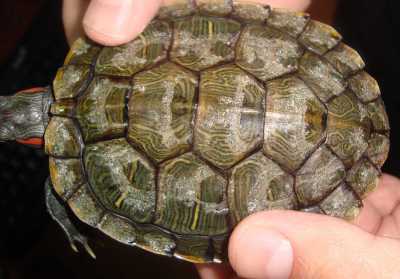
Necrosis
This is a degenerative process of tissue death as a result of the action of pathogenic bacteria and fungi. Pathology develops against the background of dermatomycosis or mechanical damage to the integrity of the shell. At the beginning of the disease, light spots appear on the paws, head and limbs of the turtle, which darken over time, swelling of the neck, limbs, deformation of the shell, and loss of claws occur. Under the influence of purulent-necrotic microflora, soft and hard tissues melt, leading to exhaustion, blood poisoning and death.
Ulcerous exfoliating disease of the shell
A disease that most often occurs when the integrity of the shell is violated. The causative agents of pathology are pathogenic fungi Candida albicans and bacteria Aeromonas hydropholy. In places of damage, ulcers are formed, covered with a white coating. With the development of the process, an increase in the size and fusion of ulcerative foci, deformation of the shell and the development of necrosis are observed. All pathologies require specific treatment, which is prescribed by a specialist after finding out the cause and establishing a diagnosis.
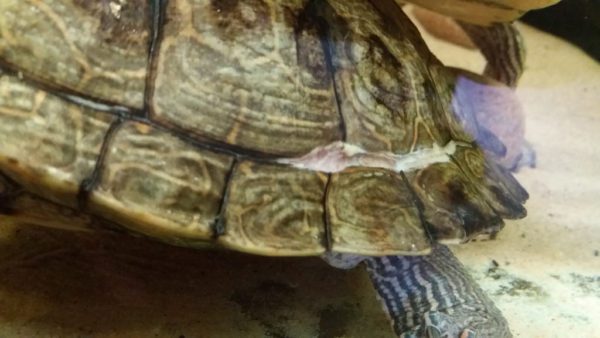
Treatment
If white spots with peeling skin are caused by a violation of molting, it is necessary to clean the shell of an aquatic pet from skin flaps, adjust the diet with the addition of vitamin-mineral complexes and increase the duration of illumination. When a pathogenic fungus is detected, therapeutic measures are aimed at destroying the causative agent of the disease and stopping the accompanying symptoms.
The scheme of treatment of mycosis in red-eared turtles:
- bathing the turtle in antibacterial and antifungal solutions: TetraMedica FungiStop, potassium permanganate, methylene blue;
- treatment of the skin and shell with fungicidal ointments: nizoral, triderm, clotrimazole, mycospor, lamisil, mycoseptin, mycosolone and Zoomikol antibacterial spray;
- therapeutic baths in a decoction of chamomile or oak bark;
- irradiation with an ultraviolet lamp for reptiles;
- disinfection of the aquarium and animal care items;
- injections of the vitamin preparation eleovit;
- proper feeding with the addition of raw sea fish, beef offal, vegetables, fruits and berries.
Depending on the condition of the small patient and the neglect of the pathology, treatment takes from 2-3 weeks to several months.
Prevention
Mycosis of aquatic turtles is quite long and difficult to treat. In order to avoid the occurrence of unpleasant ailments, it is recommended to follow preventive measures:
- regular washing and disinfection of the terrarium with methylene blue;
- the use of air conditioners, antibacterial preparations and water softeners for daily cleaning of the pool;
- providing the animal with access to land;
- arrangement of the terrarium with a daylight lamp and an ultraviolet lamp for reptiles, installed at a height of 25-30 cm;
- a balanced diet with the addition of vitamin and mineral supplements.
White spots on the shell of a tortoise
White spots on the back of a land tortoise indicate the development of various pathologies that require an appeal to a herpetologist. The most common causes of whitish spots on the shell are the following pathologies.
Mechanical damage
Injuries to the shields from falls from a height, attack by dogs, getting hit by a car or cruelty to an animal. Cracks and chips on the shell of a land reptile look like white, dry, flaky spots that cannot be cleaned off mechanically.
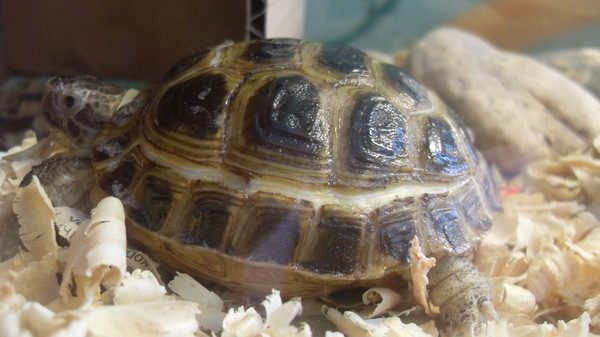
Fungal diseases
Diseases caused by pathogenic fungi Aspergillus spp., Candida spp., Fusarium incornatum, Mucor sp., Penicillium spp., Paecilomyces lilacinus. Unlike aquatic relatives, fungal pathologies in land turtles are manifested by the formation of scaly white dots on the shell, dry delamination of the scutes and weeping ulcers on the skin. Fungal lesions are easily removed with any metal object.
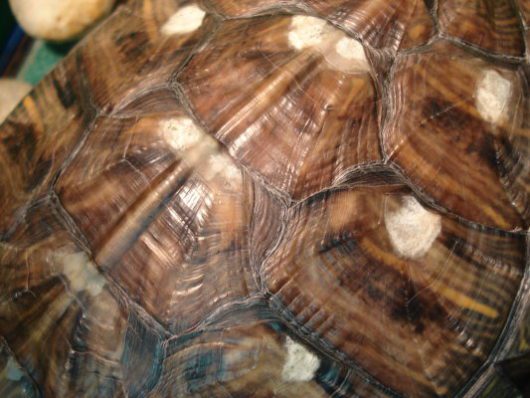
Rickets
A metabolic disorder associated with a lack of calcium and vitamin D in the body of an animal. With the disease, softening and deformation of the protective shields and bones of the limbs, swelling of the eyes and bleeding, sometimes the reptile shell becomes white.
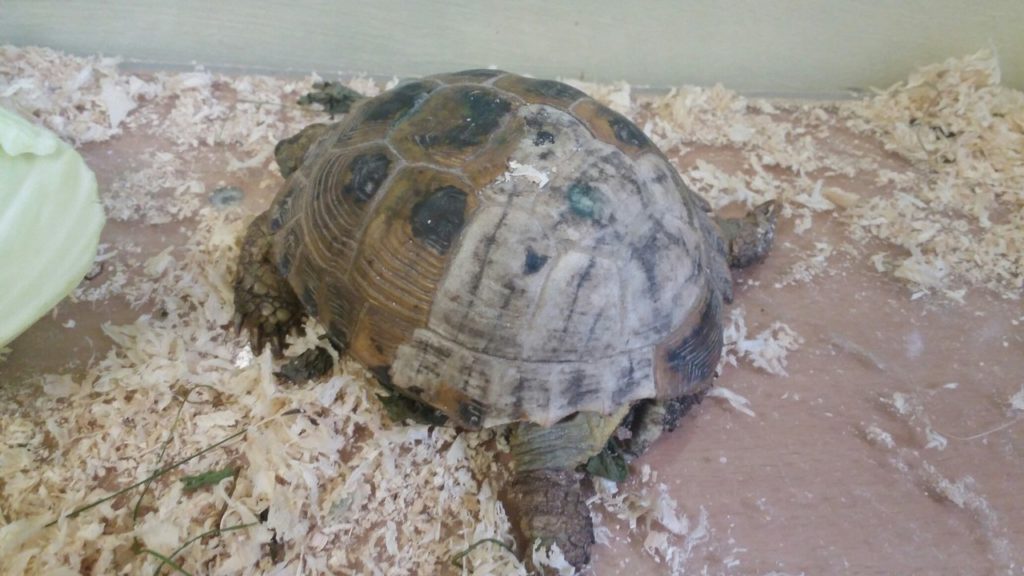
Prevention
Prevention of the formation of pathological white spots on the shell in land turtles is the correction of the diet. Unlike aquatic counterparts, Central Asian turtles mainly eat plant foods; calcium-containing and vitamin supplements for reptiles are necessarily introduced into the pet’s feed. Prevention of rickets and fungal diseases is considered to be daily exposure of the animal to a source of ultraviolet radiation and sunbathing.
Any turtle sores are better to prevent than to cure. With properly organized nutrition and maintenance, a nimble exotic pet will always be healthy and active.
White coating on the shell of red-eared and tortoises
4.5 (90.77%) 13 votes





